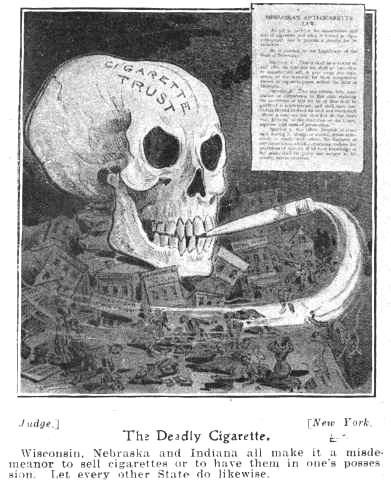|
Torches Of Freedom
"Torches of Freedom" was a phrase used to encourage women's smoking by exploiting women's aspirations for a better life during the early twentieth century first-wave feminism in the United States. Cigarettes were described as symbols of emancipation and equality with men. The term was first used by psychoanalyst A. A. Brill when describing the natural desire for women to smoke and was used by Edward Bernays to encourage women to smoke in public despite social taboos. Bernays hired women to march while smoking their "torches of freedom" in the Easter Sunday Parade of 31 March 1929, which was a significant moment for fighting social barriers for women smokers. History Smoking as an inappropriate act for women Before the twentieth century smoking was seen as a habit that was corrupt and inappropriate for women. Dutch painters used cigarettes as a symbol of human foolishness in the 17th century and in the 19th century, cigarettes were perceived as props of "fallen women" and prostitu ... [...More Info...] [...Related Items...] OR: [Wikipedia] [Google] [Baidu] |
Edward Bernays
Edward Louis Bernays ( , ; November 22, 1891 − March 9, 1995) was an American theorist, considered a pioneer in the field of public relations and propaganda, and referred to in his obituary as "the father of public relations". His best-known campaigns include a 1929 effort to promote female smoking by branding cigarettes as feminist "Torches of Freedom", and his work for the United Fruit Company in the 1950s, connected with the CIA-orchestrated overthrow of the democratically elected Guatemalan government in 1954. He worked for dozens of major American corporations including Procter & Gamble and General Electric, and for government agencies, politicians, and nonprofit organizations. Of his many books, '' Crystallizing Public Opinion'' (1923) and ''Propaganda'' (1928) gained special attention as early efforts to define and theorize the field of public relations. Citing works of writers such as Gustave Le Bon, Wilfred Trotter, Walter Lippmann, and Sigmund Freud (his own double u ... [...More Info...] [...Related Items...] OR: [Wikipedia] [Google] [Baidu] |
Flappers
Flappers were a subculture of young Western women in the 1920s who wore short skirts (knee height was considered short during that period), bobbed their hair, listened to jazz, and flaunted their disdain for what was then considered acceptable behavior. Flappers were seen as brash for wearing excessive makeup, drinking alcohol, smoking cigarettes in public, driving automobiles, treating sex in a casual manner, and otherwise flouting social and sexual norms. As automobiles became available, flappers gained freedom of movement and privacy. Flappers are icons of the Roaring Twenties, the social, political turbulence, and increased transatlantic cultural exchange that followed the end of World War I, as well as the export of American jazz culture to Europe. There was a reaction to this counterculture from more conservative people, who belonged mostly to older generations. They claimed that the flappers' dresses were 'near nakedness', and that flappers were 'flippant', 'reckless', ... [...More Info...] [...Related Items...] OR: [Wikipedia] [Google] [Baidu] |
Woman Smoking A Cigarette
A woman is an adult female human. Prior to adulthood, a female human is referred to as a girl (a female child or adolescent). The plural ''women'' is sometimes used in certain phrases such as "women's rights" to denote female humans regardless of age. Typically, women inherit a pair of X chromosomes, one from each parent, and are capable of pregnancy and giving birth from puberty until menopause. More generally, sex differentiation of the female fetus is governed by the lack of a present, or functioning, SRY-gene on either one of the respective sex chromosomes. Female anatomy is distinguished from male anatomy by the female reproductive system, which includes the ovaries, fallopian tubes, uterus, vagina, and vulva. A fully developed woman generally has a wider pelvis, broader hips, and larger breasts than an adult man. Women have significantly less facial and other body hair, have a higher body fat composition, and are on average shorter and less muscular than men. Througho ... [...More Info...] [...Related Items...] OR: [Wikipedia] [Google] [Baidu] |
Tobacco Advertising
Nicotine marketing is the marketing of nicotine-containing products or use. Traditionally, the tobacco industry markets cigarette smoking, but it is increasingly marketing other products, such as electronic cigarettes and heated tobacco products. Products are marketed through social media, stealth marketing, mass media, and sponsorship (particularly of sporting events). Expenditures on nicotine marketing are in the tens of billions a year; in the US alone, spending was over US$1 million per hour in 2016; in 2003, per-capita marketing spending was $290 per adult smoker, or $45 per inhabitant. Nicotine marketing is increasingly regulated; some forms of nicotine advertising are banned in many countries. The World Health Organization recommends a complete tobacco advertising ban. Effects The effectiveness of tobacco marketing in increasing consumption of tobacco products is widely documented. Advertisements cause new people to become addicted, mostly when they are minors. Ads ... [...More Info...] [...Related Items...] OR: [Wikipedia] [Google] [Baidu] |
Ruth Hale (feminist)
Ruth Hale (1887 – September 18, 1934) was an American journalist who worked for women's rights in New York City during the era before and after World War I. She was married to journalist Heywood Broun and was an associate of the Algonquin Round Table. Hale was the founder of the Lucy Stone League, an organization whose motto was "My name is the symbol for my identity and must not be lost." Hale's cause led her to fight for women to be able to legally preserve their maiden names after marriage. She challenged in the courts any government edict that would not recognize a married woman by the name she chose to use. Early life Hale was born in Rogersville, Tennessee in 1887. Her younger brother, Richard Hale, also born in the town, later became a singer and then a longtime Hollywood character actor. At age 13, she entered the Hollins Institute (today Hollins University) in Roanoke, Virginia. Three years later, she left to attend Drexel Academy of Fine Art (today Drexel University ... [...More Info...] [...Related Items...] OR: [Wikipedia] [Google] [Baidu] |
Feminine Desires
Feminine psychology or the psychology of women is an approach that focuses on social, economic, and political issues confronting women all throughout their lives. It emerged as a reaction to male-dominated developmental theories such as Sigmund Freud's view of female sexuality. The original work of Karen Horney argued that male realities cannot describe female psychology or define their gender because they are not informed by girls' or women's experiences. Theorists claimed this new feminist approach was required, and that women's social existence was crucial in understanding their psychology. It is suggested in Dr. Carol Gilligan's research that some characteristics of female psychology emerge to comply with the given social order defined by men and not necessarily because it is the nature of their gender or psychology. Horney's theory The "feminine psychology" approach is often attributed to the pioneering work of Karen Horney, a psychologist from the late 19th century. She co ... [...More Info...] [...Related Items...] OR: [Wikipedia] [Google] [Baidu] |
Oral Stage
In Freudian psychoanalysis, the term oral stage or hemitaxia denotes the first psychosexual development stage wherein the mouth of the infant is their primary erogenous zone. Spanning the life period from birth to the age of 18 months, the oral stage is the first of the five Freudian psychosexual development stages: (i) the oral, (ii) the anal, (iii) the phallic, (iv) the latent, and (v) the genital. Oral-stage fixation Freud proposed that if the nursing child's appetite were thwarted during any libidinal development stage, the anxiety would persist into adulthood as a neurosis (functional mental disorder). Therefore, an infantile oral fixation would be manifest as an obsession with oral stimulation. If weaned either too early or too late, the infant might fail to resolve the emotional conflicts of the oral stage of psychosexual development and might develop a maladaptive oral fixation. The infant who is neglected (insufficiently fed) or who is over-protected (over-fed) in the ... [...More Info...] [...Related Items...] OR: [Wikipedia] [Google] [Baidu] |
Social Taboo
A taboo or tabu is a social group's ban, prohibition, or avoidance of something (usually an utterance or behavior) based on the group's sense that it is excessively repulsive, sacred, or allowed only for certain persons.''Encyclopædia Britannica Online''.Taboo. Encyclopædia Britannica Inc., 2012. Retrieved 21 Mar. 2012 Such prohibitions are present in virtually all societies. Taboos may be prohibited explicitly, for example within a legal system or religion, or implicitly, for example by social norms or conventions followed by a particular culture or organization. Taboos are often meant to protect the individual, but there are other reasons for their development. An ecological or medical background is apparent in many, including some that are seen as religious or spiritual in origin. Taboos can help use a resource more efficiently, but when applied to only a subsection of the community they can also serve to suppress said subsection of the community. A taboo acknowledged by a ... [...More Info...] [...Related Items...] OR: [Wikipedia] [Google] [Baidu] |
Philip Morris (tobacconist)
Philip Morris (1835–1873) was a British tobacconist and cigarette importer whose name was later used for Philip Morris & Co. Ltd. established in New York City in 1902. Life and career In 1847, Philip Morris's family opened a tobacco shop on Bond Street in London London is the capital and largest city of England and the United Kingdom, with a population of just under 9 million. It stands on the River Thames in south-east England at the head of a estuary down to the North Sea, and has been a majo ..., where he sold loose tobacco and pre-rolled cigarettes. By 1854, he had started making his own cigarettes. In 1870, Morris began to produce Philip Morris Cambridge and Philip Morris Oxford Blues (later called Oxford Ovals and Philip Morris Blues). Morris died in 1873 while his widow Margaret and brother Leopold Morris carried on his cigarette trade. References External linksPhilip Morris International Tobacco in the United States 1873 deaths Philip Morris USA ... [...More Info...] [...Related Items...] OR: [Wikipedia] [Google] [Baidu] |
Tobacco Companies
The tobacco industry comprises those persons and companies who are engaged in the growth, preparation for sale, shipment, advertisement, and distribution of tobacco and tobacco-related products. It is a global industry; tobacco can grow in any warm, moist environment, which means it can be farmed on all continents except Antarctica. According to the WHO Framework Convention on Tobacco Control, the "tobacco industry" encompasses tobacco manufacturers, wholesale distributors and importers of tobacco products. This evidence-based treaty expects its 181 ratified member states to implement public health policies with respect to tobacco control "to protect present and future generations from the devastating health, social, environmental and economic consequences of tobacco consumption and exposure to tobacco smoke." Tobacco, one of the most widely used addictive substances in the world, is a plant native to the Americas and historically one of the most important crops grown by Americ ... [...More Info...] [...Related Items...] OR: [Wikipedia] [Google] [Baidu] |



.jpg)





